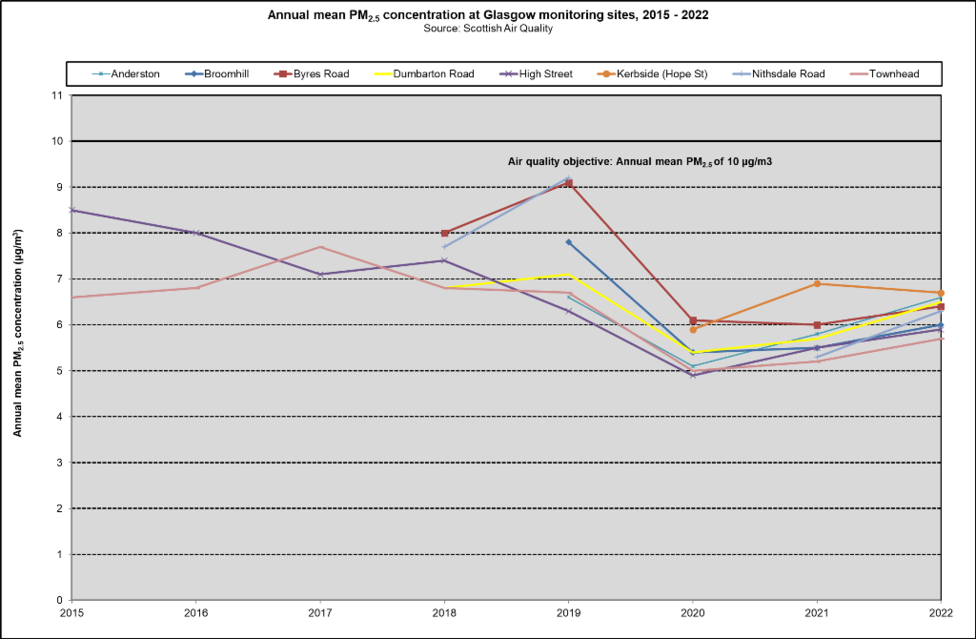Glasgow trends
Small particulate matter
Small particulate matter (PM2.5 – atmospheric particulate matter with a diameter of less than 2.5 micrometers) is made up of fine particles that can be carried deep into the lungs where they can cause inflammation and a worsening of the condition of people with heart and lung diseases. They may also carry harmful compounds, absorbed on their surfaces, into the lungs. Current evidence suggests that there is no safe level of particulate matter in terms of human health effects.
Trends in estimated mean concentrations of manmade (anthropogenic) PM2.5 at sites in Glasgow, 2015 - 2022
Annual mean PM2.5 concentrations at all the recording sites in Glasgow have remained below the Air Quality Objective of 10 µg m-3 since recording started in 2015.
PM10
PM10 denotes particulate matter 10 micrometers or less in diameter.
Current evidence suggests that there is no safe level of particulate matter in terms of human health effects. PM10 is among the most harmful of all air pollutants. When inhaled, these particles evade the respiratory system's natural defences and lodge deep in the lungs. Health problems begin as the body reacts to these foreign particles. PM10 can increase the number and severity of asthma attacks, cause or aggravate bronchitis and other lung diseases, and reduce the body's ability to fight infections.
Particulate matter (PM10) concentration at Glasgow monitoring sites, 2000 - 2022
 The chart above shows trends in the annual mean concentration of PM10 in the air at various monitoring stations across Glasgow since 2000. These measurements can be compared to the Air Quality Strategy (AQS) objective of PM10 concentrations not exceeding 18μg/m3. A small number of sites have breached the objective in recent years but the overall trends in measurements appears to be downward. There was a notable reduction in PM10 concentrations in 2020 followed by a rise again in 2021. This is likely to be at least partly attributable to the reduction in traffic during the early phases of the COVID-19 pandemic, which was followed by traffic levels returning almost to pre-pandemic levels in 2021.
The chart above shows trends in the annual mean concentration of PM10 in the air at various monitoring stations across Glasgow since 2000. These measurements can be compared to the Air Quality Strategy (AQS) objective of PM10 concentrations not exceeding 18μg/m3. A small number of sites have breached the objective in recent years but the overall trends in measurements appears to be downward. There was a notable reduction in PM10 concentrations in 2020 followed by a rise again in 2021. This is likely to be at least partly attributable to the reduction in traffic during the early phases of the COVID-19 pandemic, which was followed by traffic levels returning almost to pre-pandemic levels in 2021.
NO2
The main effect of breathing in raised levels of NO2 (nitrogen dioxide) is the increased likelihood of respiratory problems. Nitrogen dioxide inflames the lining of the lungs, and it can reduce immunity to lung infections. This can cause problems such as wheezing, coughing, colds, flu and bronchitis.
Nitrogen dioxide levels at Glasgow monitoring sites, 1987-2022
 The chart above shows trends in the annual mean concentration of NO2 recorded at monitoring sites in Glasgow since 1987. Recorded concentrations of this air pollutant have been reducing over the last decade and, in 2022, there were no recording sites that breached the annual mean Air Quality Strategy (AQS) objective for NO2(40μg/m3).
The chart above shows trends in the annual mean concentration of NO2 recorded at monitoring sites in Glasgow since 1987. Recorded concentrations of this air pollutant have been reducing over the last decade and, in 2022, there were no recording sites that breached the annual mean Air Quality Strategy (AQS) objective for NO2(40μg/m3).
There was a notable reduction in NO2 concentrations at most sites in 2020, followed by a rise again in 2021. This is likely to be at least partly attributable to the reduction in traffic during the early phases of the COVID-19 pandemic, which was followed by traffic levels returning almost to pre-pandemic levels in 2021.
Notes
The Air Quality in Scotland site provides up-to-date estimates of air quality from monitoring sites across Scotland.
In 2016, Scotland opted to make its annual mean PM2.5 objective more stringent by reducing it from 12 µg m-3 to 10 µg m-3 in line with the World Health Organization guideline.
The Scottish Government's air quality policy: Cleaner Air for Scotland 2 - Towards a Better Place for Everyone
A Low Emission Zone (LEZ) came into force in Glasgow City Centre on 1 June 2023. This means all vehicles entering the city centre zone need to meet specific pollution emission standards or face a penalty charge. There are further details on the Glasgow LEZ in this blog.
This page was updated in July 2023.
